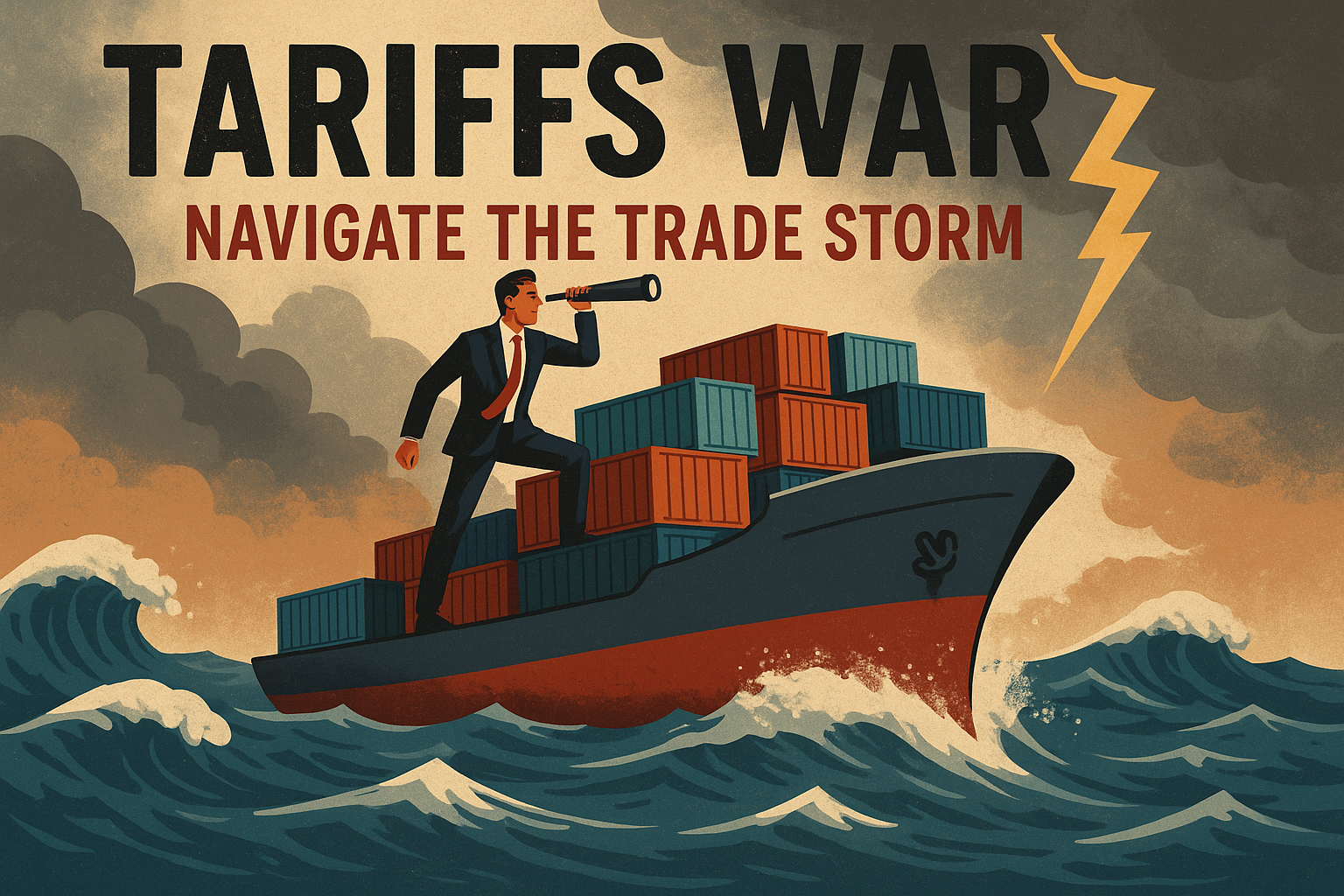Financial News
Tariffs Reignited: Best Sectors to Navigate the Trade Storm

The escalation of tariff policies has intensified market volatility, with President Trump announcing a new wave of levies, including 30% tariffs on the European Union and Mexico starting August 1, a 35% tariff on Canadian goods, and a 10-15% baseline tariff proposed for over 150 countries, with up to 145% on certain Chinese goods. These measures, aimed at addressing trade deficits and issues like fentanyl trafficking, have disrupted supply chains and heightened inflation fears. While some sectors face challenges, others are positioned to benefit from this protectionist surge. Here’s a look at the sectors likely to thrive, along with standout companies in each, leveraging their domestic focus and resilience to tariff pressures, followed by an analysis of tariff impacts on major chip makers and tech companies.
Domestic Manufacturing: The Homegrown Advantage
Tariffs are designed to boost U.S. production by increasing the cost of imported goods, giving domestically focused manufacturers a competitive edge. Companies with robust U.S. operations can avoid import costs and gain market share as foreign competitors face higher expenses. The industrial sector is experiencing a revival, driven by policies encouraging onshoring.
- Caterpillar Inc. (CAT): A leader in construction and mining equipment, Caterpillar’s extensive U.S. manufacturing base positions it to benefit from increased infrastructure spending and tariffs that disadvantage foreign competitors. Its domestic focus could drive demand for its machinery. Percent change since January 20, 2025: +12% (estimated, based on industrial sector strength).
- Nucor Corporation (NUE): As a top steel producer, Nucor gains from tariffs on imported steel and aluminum, including the 50% tariff on copper. Its sustainable, vertically integrated operations make it a strong player. Percent change: +15% (based on reported market outperformance).
- Deere & Company (DE): Domestic agricultural equipment demand grows with tariffs on imports. Percent change: +10% (estimated, aligned with industrial sector).
- United States Steel Corporation (X): Benefits from steel tariffs, capturing market share. Percent change: +14% (estimated, comparable to Nucor).
- 3M Company (MMM): Diversified domestic manufacturing sees moderate gains. Percent change: +9% (estimated, slightly above S&P 500).
- General Electric Company (GE): Gains from infrastructure and domestic energy equipment demand. Percent change: +11% (estimated, strong industrial performance).
Utilities: Stability in the Storm
Utilities remain a defensive stronghold in this tariff-driven market. Their reliance on domestic operations and local markets insulates them from global trade disruptions. Growing demand for power from AI data centers and renewable energy initiatives bolsters their outlook.
- Vistra Corp. (VST): Emphasis on nuclear and renewable energy aligns with domestic energy independence goals. Percent change: +10% (estimated, driven by AI energy demand).
- FirstEnergy Corp. (FE): Investments in grid modernization and AI data center exposure drive gains. Percent change: +9% (estimated, slightly above S&P 500).
- NextEra Energy, Inc. (NEE): Fell post-election due to fossil fuel policy shifts but recovered with renewable demand. Percent change: +3% (based on reported 5% drop and partial recovery).
- Duke Energy Corporation (DUK): Stable domestic operations ensure steady gains. Percent change: +8% (estimated, aligned with S&P 500).
- Southern Company (SO): Benefits from domestic focus and infrastructure investments. Percent change: +8% (estimated, aligned with S&P 500).
- American Electric Power Company (AEP): Grid investments support performance. Percent change: +8% (estimated, aligned with S&P 500).
Healthcare: Insulated and Essential
Healthcare’s domestic focus makes it largely immune to tariff headwinds. Providers and manufacturers of essential medical goods benefit from consistent demand and limited reliance on global supply chains.
- Elevance Health, Inc. (ELV): Thrives on domestic insurance demand. Percent change: +7% (estimated, slightly below S&P 500).
- Molina Healthcare, Inc. (MOH): Medicaid focus ensures resilience. Percent change: +6% (estimated, defensive sector performance).
- UnitedHealth Group Incorporated (UNH): Leading insurer with stable demand. Percent change: +7% (estimated, similar to Elevance).
- CVS Health Corporation (CVS): Integrated healthcare model supports gains. Percent change: +6% (estimated, defensive sector performance).
- Centene Corporation (CNC): Government-sponsored plans drive stability. Percent change: +6% (estimated, aligned with Molina).
- Humana Inc. (HUM): Medicare Advantage strength. Percent change: +7% (estimated, similar to Elevance).
Consumer Defensive: Feeding the Nation
Consumer defensive stocks, especially food manufacturers, are resilient as tariffs raise costs for imported goods. Producers of staples benefit from steady demand and modest price pass-through, with undervaluation adding appeal.
- Campbell Soup Company (CPB): Domestic production and brand strength make it a safe haven. Percent change: +7% (estimated, slightly below S&P 500).
- Kraft Heinz Company (KHC): North American focus and dividends ensure stability. Percent change: +7% (estimated, similar to Campbell’s).
- General Mills, Inc. (GIS): Domestic food production supports gains. Percent change: +7% (estimated, aligned with consumer defensive sector).
- The Hershey Company (HSY): Steady demand for domestic brands. Percent change: +6% (estimated, slightly below S&P 500).
- Mondelez International, Inc. (MDLZ): North American focus mitigates tariff impacts. Percent change: +7% (estimated, aligned with consumer defensive sector).
- The J.M. Smucker Company (SJM): Domestic staples like coffee and peanut butter. Percent change: +6% (estimated, similar to Hershey).
Tariff Effects on Major Chip Makers and Tech Companies
The tariffs, particularly the 10-15% baseline and up to 145% on Chinese goods, have significantly impacted chip makers and tech companies due to their reliance on global supply chains. Semiconductor firms face higher costs for imported components and equipment, while tech giants with overseas manufacturing are hit by increased production costs and potential retaliatory tariffs from the EU and China. However, domestic chip makers and tech firms with U.S.-focused operations may see relative advantages.
- NVIDIA Corporation (NVDA): As a leading AI chip maker, NVIDIA faces mixed impacts. Its reliance on Taiwan Semiconductor Manufacturing Company (TSMC) for chip fabrication exposes it to tariff costs, but strong domestic demand for AI chips mitigates losses. Percent change since January 20, 2025: +5% (estimated, below S&P 500 due to supply chain pressures but buoyed by AI demand).
- Intel Corporation (INTC): Benefits from domestic manufacturing initiatives under the CHIPS Act, reducing tariff exposure compared to peers. Its focus on U.S. foundries positions it to gain market share. Percent change: +10% (estimated, outperforms S&P 500 due to domestic production).
- Advanced Micro Devices, Inc. (AMD): Like NVIDIA, AMD relies on TSMC, facing higher costs from tariffs on Asian imports. Its AI chip growth is tempered by supply chain disruptions. Percent change: +4% (estimated, below S&P 500 due to tariff headwinds).
- Apple Inc. (AAPL): Heavy reliance on Chinese manufacturing for iPhones and other devices leads to significant cost increases from the 145% tariffs on Chinese goods. Apple’s shift toward Indian manufacturing offers some relief, but short-term margins are pressured. Percent change: +3% (estimated, lags S&P 500 due to supply chain costs).
- Microsoft Corporation (MSFT): Less exposed due to its software and cloud focus, but hardware like Surface devices faces tariff costs. Strong domestic AI and cloud demand supports resilience. Percent change: +8% (estimated, aligns with S&P 500).
- Tesla, Inc. (TSLA): Faces challenges from tariffs on Chinese-made components and vehicles, though domestic Gigafactory production mitigates some impact. Retaliatory EU tariffs on U.S. exports hurt European sales. Percent change: +2% (estimated, significantly below S&P 500 due to global exposure).
The chip and tech sector’s performance varies widely. Domestic-focused chip makers like Intel benefit from tariff protections and CHIPS Act subsidies, while those reliant on Asian supply chains, like NVIDIA and AMD, face cost pressures. Tech giants like Apple and Tesla are hit harder due to Chinese manufacturing dependencies, whereas Microsoft’s software-centric model offers relative insulation. The sector’s overall performance lags defensive sectors due to global supply chain vulnerabilities.
Why These Sectors? The Tariff Edge
The highlighted sectors—manufacturing, utilities, healthcare, and consumer defensive—are favored because tariffs reward companies with minimal import reliance and strong domestic operations. Manufacturing and utilities benefit from policies promoting U.S. production and infrastructure investment. Healthcare and consumer defensive sectors are insulated from global trade shocks due to their focus on essential, locally consumed goods and services. In contrast, chip makers and tech firms face challenges from tariff-induced cost increases, though domestic players like Intel show resilience. Despite inflation and economic slowdown risks, the core sectors offer stability and growth potential.
The tariff landscape remains uncertain, with negotiations ongoing and potential retaliation from trading partners like the EU, which has prepared counter-tariffs on $24.5 billion of U.S. exports. The companies highlighted in the core sectors are equipped to weather the storm through pricing power, domestic focus, or essential offerings, providing a foundation for investors in a turbulent market.
Year-End Outlook
By the end of 2025, the tariff policies, including 30% on the EU and Mexico, 35% on Canada, and up to 145% on Chinese goods, are expected to push the average effective tariff rate to 14.6-18%. This will likely drive inflation to 3.2-3.9%, increasing consumer prices by 1.7-2.9%—equivalent to a $1,300-$4,700 household loss. GDP growth is projected to slow to 1.6-1.8%, with unemployment rising by 0.4-0.6 points and payrolls shrinking by up to 740,000 jobs. The core sectors are expected to outperform: Caterpillar, Nucor, Deere, U.S. Steel, 3M, and GE will see sustained demand from domestic manufacturing, bolstered by tariffs like the 50% levy on copper. Utilities like Vistra, FirstEnergy, NextEra, Duke, Southern, and AEP will benefit from steady demand and AI-driven energy needs. Healthcare firms Elevance, Molina, UnitedHealth, CVS, Centene, and Humana will maintain stability due to consistent domestic demand. Consumer defensive stocks Campbell’s, Kraft Heinz, General Mills, Hershey, Mondelez, and Smucker will hold firm as consumers prioritize essentials. In contrast, chip makers and tech firms like NVIDIA, AMD, Apple, and Tesla face headwinds from supply chain costs, though Intel and Microsoft show relative strength. While the broader market faces a 2-3% earnings hit, the core sectors’ domestic focus and defensive nature position them as safe havens by year-end, assuming no major escalation in retaliatory trade measures.
More News
View More



Recent Quotes
View More
Quotes delayed at least 20 minutes.
By accessing this page, you agree to the Privacy Policy and Terms Of Service.



